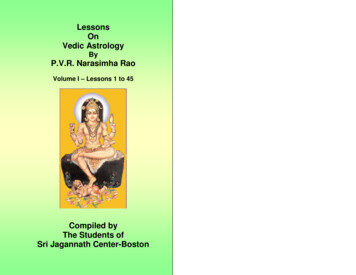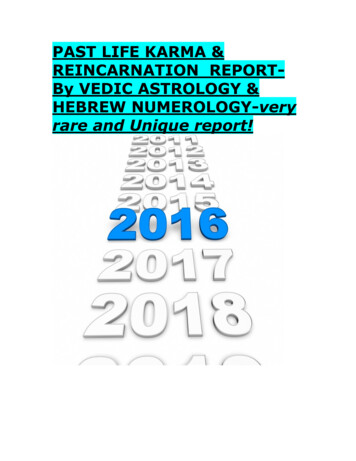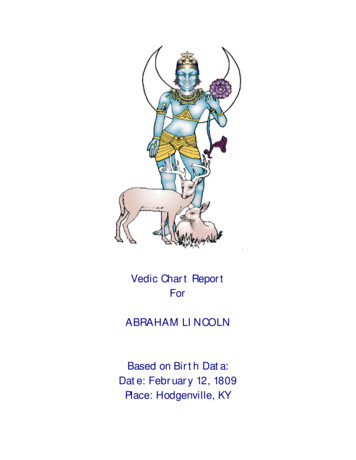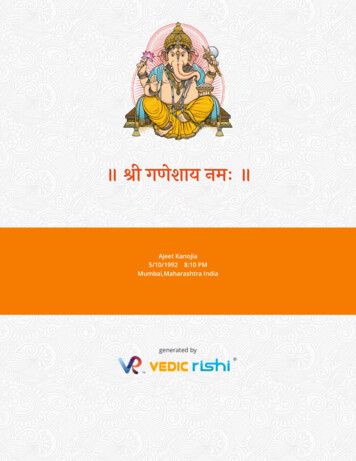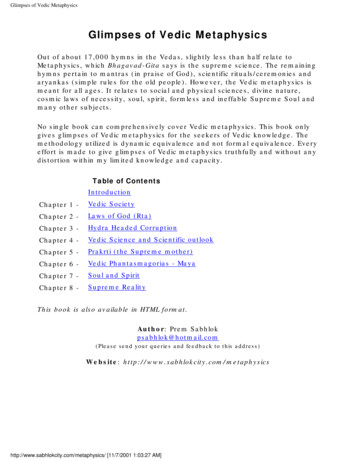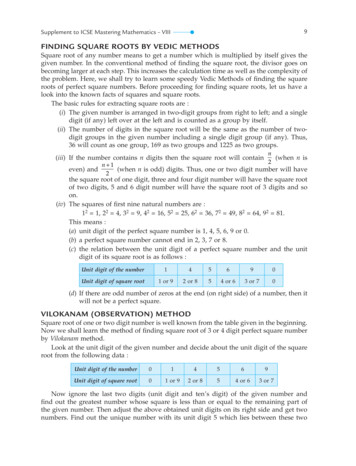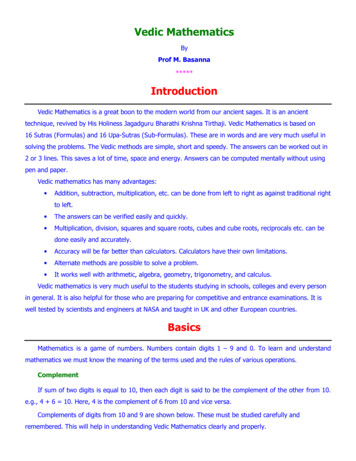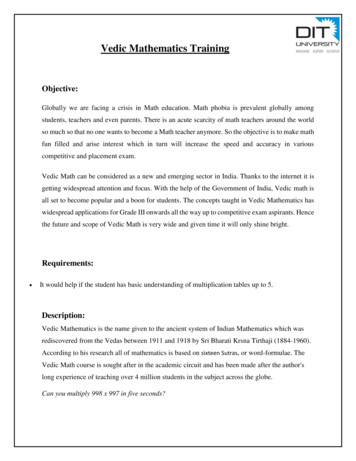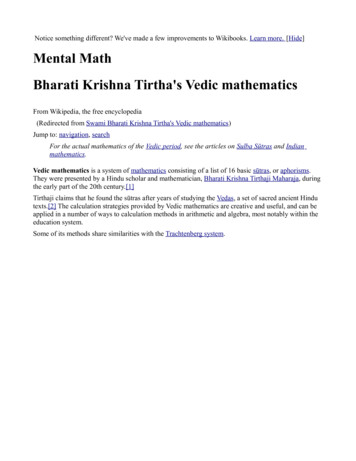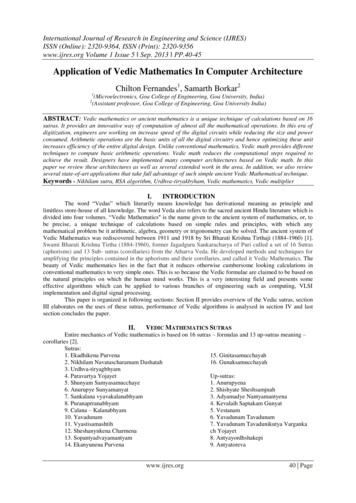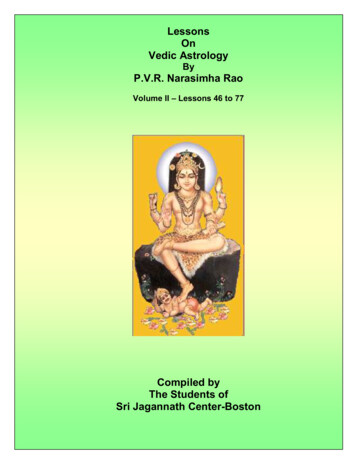
Transcription
LessonsOnVedic AstrologyByP.V.R. Narasimha RaoVolume II – Lessons 46 to 77Compiled byThe Students ofSri Jagannath Center-Boston
LessonsOnVedic AstrologyByP.V.R Narasimha RaoVolume II(Lessons 46 – 77)Compiled byThe Students ofSri Jagannath il: vedicastro@comcast.net
First Print 2007 P.V.R.Narasimha Rao, Sri Jagannath Center-BostonPublished by the students of Sri Jagannath Center – Boston, on the occasion of Guru Purnima:29 July 2007.Lessons on Vedic Astrology – Volume IIii
OM SRI MAHAGANAPATHAYE NAMAHPrayerGananaam twa Ganapatim Havamahey Kavim KavinamupamasravastamamJyestharajam Brahmanaam Brahmanaspata Aa Nah Sranavannutibhih Sidda SadanamTranslation: O Ganesha, Lord of all seers, praise be to Thee; Thou art Omniscient and the unmatched wisdom of the wise. Thou art theprecursor (OM) of all prayers and the Lord of all souls; we pray for Thy guidance for success in all good actions.Translation: O Great Men! We sing the praise of Brihaspati (the preceptor of the Gods) for the joy of learning and for success in all our goodactions. He is the most respectable and the greatest. His wishes are inviolable and we gain in (spiritual) strength by following in His footsteps.Lessons on Vedic Astrology – Volume II3
DedicationWe dedicate these efforts at the feet of our Jyotish Guru Sri. P.V.R. Narasimha Raowho is relentlessly working to spread the Vedic Astrology knowledge and selflesslyconducting the Vedic Astrology classes in Boston, USA.Lessons on Vedic Astrology – Volume II4
About our GuruSri. P.V.R.Narasimha Rao is an engineer by profession. He did his bachelors in ElectricalEngineering from Indian Institute of Technology, Madras, India. He did his masters from RiceUniversity, Houston, USA. He works as a software engineer near Boston, USA.He is seriously interested in Jyotish and Sanskrit Literature. His academic record includes twodiplomas equivalent to bachelor’s degree in Sanskrit at a young age: Sanskrita BhaashaaKovida diploma from Bharatiya Vidya Bhavan at the age of 10 and Sanskrita BhaashaaVisaarada diploma from board of Baroda at the age of 11.He has learnt Vedic Astrology from his father Sri.Venkata Subrahmanyachalapathi Rao,Dr.B.V.Raman and Pt.Sanjay Rath, Founder of “Sri Jagannath Center”. Sri.P.V.R. NarasimhaRao is an ardent student of Jyotish and is designated Jyotish Guru at “Sri Jagannath Center”.Lessons on Vedic Astrology – Volume II5
PREFACEWe are very happy to present this work for the rest of the Vedic Astrology student community. We thestudents of SJC-Boston group are very fortunate to have a Jyotish Guru like Sri. PVR Narasimha Rao, teach usthe concepts in Vedic Astrology from ground zero. We have been maintaining the mp3 audio of these lessons athttp://vedicastro.home.comcast.net We have earlier compiled 1-45 lessons as volume-I and we have receivedgood feedback indicating it was useful and hence we are compiling lessons 46-77 and is being released asvolume-II. We hope this volume will supplement the mp3 audio as volume-I did.We realized that when we wanted to go back and listen to a particular concept, it has been very difficultto track where that concept was talked about and in which lesson. So, it was an idea to provide a summary ofeach class highlighting the topics covered and the keynotes for each of the classes. That is the purpose of thisbook. A different student summarized each lesson and we tried to keep the overall format of the structure verysimilar. But, there would be some differences in the presentation due to individual’s style of writing.Each of the classes has several important concepts covered, examples solved along with key points inastrology that were relevant to the topic of discussion but, not really part of the concept that was being talkedabout. The intention was to capture all those points under “key points” section. In most cases other than theobvious the name of the person in the example charts is left out in this book so that, the listener of the audio willnot be biased while analyzing the chart. In this volume we are capturing all lessons from 46 through 77 whichwere taught between July 2005 and August 2006. Appendix “A” highlights all the abbreviations used in this book.Appendix “B” is gives quick reference of all the lessons with example chart’s data.We are extremely thankful to Sri. P.V.R. Narasimha Rao for teaching the classes to benefit all astrologystudents.We are thankful to Pt. Sanjay Rath for the astrology conferences and allowing us to associate with SriJagannath Center for learning of Vedic Astrology.We are thankful to Sri.Narayan Iyer of Sri Jagannath Center for readily accepting our request to proofreadand provide guidance.Our thanks to Master Manasvi Putcha for the graphics on the cover design.Our sincere thanks to Sri. Prabhu Hingorani and Smt. Savitri Hingorani of Sadhu Vaswani Center, Dracut,Massachusetts, USA for giving us the premises free of cost for conducting the astrology classes.Any mistakes in this book are totally on that part of us, the students and will rectify them as they arenoticed.Students of NarasimhaSJC-Boston29 July 2007.Lessons on Vedic Astrology – Volume II6
CONTENTSLesson #46 – Muhurtha, Siddhamsa Discussion . 8Lesson #47 – Shastiamsa . 13Lesson #48 – Example and Digbala. 16Lesson #49 – Example Analysis of D30, D16. 19Lesson #50 – Daily Tithi Pravesa Charts. 25Lesson #51 - Example Analysis on Navamsa, Saptamsa and Dasamsa . 30Lesson #52 – Daily TP charts . 34Lesson #53 - Muhurtha, Spiritual analysis, Example Charts. 37Lesson #54 – Sudarshan Chakra Dasa Introduction . 39Lesson #55 – Examples, Sudarshan Chakra Dasa . 42Lesson #56 – Sudarshana Chakra Dasa with Ashtakavarga . 45Lesson #57 – Sudarshan Chakra Dasa Continuation . 47Lesson #58 – Arudhas and their significance . 50Lesson #59 – Mundane Charts. 52Lesson #60 – Several General Topics. 59Lesson #61 – Example - Politics. 63Lesson #62 – Political Example Analysis. 68Lesson #63 – Panchanga and Tribhagi Vimsottari Dasa . 72Lesson #64 - Continuation to Tribhagi Vimsottari Dasa and Sarvatobhadra chakra (SBC) . 76Lesson #65 – Examples on Lunar, Finance New Year charts . 79Lesson #66 – Examples and Dasa Mahavidya. 82Lesson #67 - Discussion on Dasamasa . 84Lesson #68 – Puzzle Chart. 88Lesson #69 – Spirituality . 94Lesson #70 – Mental Afflictions. 100Lesson #71 – Discussion on D30 and example . 106Lesson #72 - Dasamsa Discussion. 114Lesson #73 – Chaturthamsa . 118Lesson #74 – Chaturthamsa . 124Lesson #75 – Discussion on Navamsa. 129Lesson #76 – Child runs away from home . 134Lesson #77 – Divorce and Second Marriage . 141Lessons on Vedic Astrology – Volume II7
Lesson #46 – Muhurtha, Siddhamsa DiscussionCompiled by Sivarama Seshu PutchaTopics Covered:1. Muhurtha - Introduction2. Example Chart1: May 13, 1997, 12:01:30p.m, day light savings time, Andover, Ma,USA, 71W08’15”, 42N39’30”. Analysis ofMuhurtha when the book “Vedic Astrology– Integrated Approach” was started.3. Example Chart 2: Discussion on MarriageMuhurtha.4. Example chart 3: Discussion onSiddhamsaKey Points:1. The muhurtha is chosen for a particularevent. Same muhurtha will not be suitablefor all events.2. Use the book “Muhurtha, Electionalastrology” by Dr.B.V.Raman for detailedinformation. Panchangam also has thedetails. We will cover Tara in detail in thisclass.3. There are Nav taras from Moon. CertainTaras are considered good and certainare considered bad for different peopleand are certain starts are consideredgood for certain activities.4. Similarly, several tithi’s are good and badfor a specific purpose. Thus, we see taraand Nakshatra being good for a specificpurpose as well as good for that person.5. The five panchanga elements are Tithi,Varam, Nakshatram, Karanam andYogam.6. Tatwa of these elements: Tithi is Jalatatwa, shows Prosperity and well being;Vara is of Agni Tatwa, shows vitality andlongevity and the life force, see for thestrength Varesha in the chart; Karana isof earthy nature, shows the achievement.Some karanas are good and some arebad, for example Garija Karana is good;Yoga is akasa tatwa, has no specific formand it is that which binds all otherelements together. There would be forcesthat pull in different directions on anyventure and it is this yoga that keepsthem bound together; Nakshatra is vayutatwa, shows strength and utilization ofstrength. Too strong vayu could alsodamage the venture. Weak nakshatra willshow the lack of strength.7. Apart from seeing that the specificelements are good for the purpose, wealso need to see the strength of the lordof these elements in the chart. Forexample, garija Karana is auspicious andwe need to have Ju well placed in thechart to have a good achievement in theventure.8. Ideally all the five elements need beauspicious and good in the chart as welland such a condition is almost difficult tohave. So, choose the Muhurtha with theconcerned elements being good for thespecific purpose as we may not be ableto satisfy all the five elements. For ex.,choose well being if you want to get amuhurtha to start taking a medicine, sochoose strong Nakshatra and Yoga tohave effectiveness and strength. Formarriage, choose Yoga and Vara andKarana etc.So, choose the particularelement that is most essential for everyspecific muhurtha.9. There are Nav Taras from moon. (Thereare Nav taras from Lagna too, but fromMoon are important). The names are selfexplanatory. The Nakshatra at the time ofbirth becomes Janma Tara and the nextfollows the list below. When all the ninetars are completed, the cycle repeats for2 more times covering the 27 Nakshatras.a. Janma Tara – Birth Star. This isconsidered good for certain andbad for most aspects. It could begood for specific pujas etc.b. Sampath Tara – Wealth, chooseLessons on Vedic Astrology – Volume II8
this for money related mattersc. Vipat Tara – Danger stard. Kshema Tara – Well Being,choose this for health relatedaspectse. Pratyak Tara – Obstructionsf. Saadhana Tara – Achievement,choose this for job matters etc.g. Naidhana Tara – Death starh. Mitra Tara – Friendly stari. Param Mitra Tara – Very friendlystar10. All the three Janma Taras are ruled byone graha. All the three Kshema Tarasare ruled by one graha and so on.11. This logic can also be used in Vimsottaridasa as, the period of the planet rulingthe Kshema Tara will result in well beingand the period of the lord of Pratyak Taracould result in some obstacles etc 12. To identify the corresponding tara, seewhere the Mo is and see the Nakshatra atthe time of muhurtha. From the table ofnavTaras from Mo, see correspondingtara from the nakshatra at the time ofmuhurtha to the Janma nakshatra of thenative.13. Some people believe Abhijit muhurtha tobe good, but if you do the event at theexact cusp of the abhijit muhurtha, it maybe ok. Either case, select the muhurthasatisfying the most required aspects forthat event. It becomes difficult whenselecting a muhurtha for starting acompany by 5 people, you can’t get a wellmatching tara satisfying all t
Lessons on Vedic Astrology – Volume II 6 PREFACE We are very happy to present this work for the rest of the Vedic Astrology student community. We the students of SJC-Boston group are very fortunate to have a Jyotish Guru like Sri. PVR Narasimha Rao, teach us the concepts in Vedic Astrology from ground zero. We have been maintaining the mp3 audio of these lessons at


